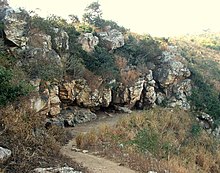| Revision as of 19:39, 8 November 2017 editSpasemunki (talk | contribs)Extended confirmed users, Rollbackers5,396 edits Add context, link to translation of vinaya source← Previous edit | Revision as of 02:46, 30 December 2017 edit undoWikiman5676 (talk | contribs)Extended confirmed users5,400 edits →Description: add infoTag: Visual editNext edit → | ||
| Line 6: | Line 6: | ||
| ==Description== | ==Description== | ||
| ] in ], where the First Buddhist Council may have been held.]] | ] in ], where the First Buddhist Council may have been held.]] | ||
| A council of 500 ] was held at ] (Sanskrit: Rājagṛha) to agree the contents of the Dhamma and Vinaya.<ref>Harvey, Peter (2013). ''An Introduction to Buddhism: Teachings, History and Practices (2nd ed.).'' Cambridge, UK: Cambridge University Press. pg. 88.</ref> ] recited the Suttas, such that each begins: ‘Thus have I heard’.<ref>Harvey, Peter (2013). ''An Introduction to Buddhism: Teachings, History and Practices (2nd ed.).'' Cambridge, UK: Cambridge University Press. pg. 88.</ref> The monk ] (Sanskrit उपालि upāli) recited the Vinaya.<ref>Harvey, Peter (2013). ''An Introduction to Buddhism: Teachings, History and Practices (2nd ed.).'' Cambridge, UK: Cambridge University Press. pg. 88.</ref> | A council of 500 ] was held at ] (Sanskrit: Rājagṛha) three months following the Buddha's death to agree the contents of the Dhamma and Vinaya.<ref>Harvey, Peter (2013). ''An Introduction to Buddhism: Teachings, History and Practices (2nd ed.).'' Cambridge, UK: Cambridge University Press. pg. 88.</ref><ref>{{Cite web|url=https://www.buddhanet.net/e-learning/buddhism/lifebuddha/2_32lbud.htm|title=Life of Buddha: The 1st Buddhist Council (Part 2)|website=www.buddhanet.net|access-date=2017-12-30}}</ref> The meeting was led by ] under patronage of the king ]. Its objective was to preserve the Buddha's sayings (]) and the monastic discipline or rules (]). Also, the ] made the unanimous decision to keep all the rules of the Vinaya, even the lesser and the minor rules. ] recited the Suttas, such that each begins: ‘Thus have I heard’.<ref>Harvey, Peter (2013). ''An Introduction to Buddhism: Teachings, History and Practices (2nd ed.).'' Cambridge, UK: Cambridge University Press. pg. 88.</ref> The monk ] (Sanskrit उपालि upāli) recited the Vinaya.<ref>Harvey, Peter (2013). ''An Introduction to Buddhism: Teachings, History and Practices (2nd ed.).'' Cambridge, UK: Cambridge University Press. pg. 88.</ref> According to D.N. commentary's introduction, the ] and ancient commentary was also included. | ||
| ==See also== | ==See also== | ||
Revision as of 02:46, 30 December 2017

| Part of a series on |
| Early Buddhism |
|---|
 |
| Buddhism |
Scriptures
|
| Early sangha |
| Pre-sectarian Buddhism |
Early Buddhist schools
|
| Terms |
The First Buddhist council was a gathering of senior monks of the Buddhist order convened just after the Buddha's passing away in ca. 400 BCE. The story of the gathering is recorded in the Vinaya Pitaka of the Theravadins and Sanskrit Buddhist schools. It is regarded as canonical by all schools of Buddhism, but in the absence of evidence from outside the Buddhist sutras has not generally been accepted as a historical event by other scholars.
Description

A council of 500 Arahats was held at Rajgir (Sanskrit: Rājagṛha) three months following the Buddha's death to agree the contents of the Dhamma and Vinaya. The meeting was led by Mahakasyapa under patronage of the king Ajatashatru. Its objective was to preserve the Buddha's sayings (suttas) and the monastic discipline or rules (Vinaya). Also, the Sangha made the unanimous decision to keep all the rules of the Vinaya, even the lesser and the minor rules. Ananda recited the Suttas, such that each begins: ‘Thus have I heard’. The monk Upali (Sanskrit उपालि upāli) recited the Vinaya. According to D.N. commentary's introduction, the Abhidhamma Pitaka and ancient commentary was also included.
See also
- Buddhist councils
- Second Buddhist council
- Third Buddhist council
- Fourth Buddhist council
- Fifth Buddhist council
- Sixth Buddhist council
External Links
- Recitation of the Five Hundred (English translation) - The traditional story of the First Council, as recorded in the Pali Canon.
References
- Harvey, Peter (2013). An Introduction to Buddhism: Teachings, History and Practices (2nd ed.). Cambridge, UK: Cambridge University Press. pg. 88.
- Bechert, Heinz; Akademie der Wissenschaften in Göttingen, eds. (1995). When did the Buddha live?: the controversy on the dating of the historical Buddha. Delhi, India: Sri Satguru Publications. ISBN 8170304695.
- Harvey, Peter (2013). An Introduction to Buddhism: Teachings, History and Practices (2nd ed.). Cambridge, UK: Cambridge University Press. pg. 88.
- "Life of Buddha: The 1st Buddhist Council (Part 2)". www.buddhanet.net. Retrieved 2017-12-30.
- Harvey, Peter (2013). An Introduction to Buddhism: Teachings, History and Practices (2nd ed.). Cambridge, UK: Cambridge University Press. pg. 88.
- Harvey, Peter (2013). An Introduction to Buddhism: Teachings, History and Practices (2nd ed.). Cambridge, UK: Cambridge University Press. pg. 88.
Bibliography
- Harvey, Peter (2013). An Introduction to Buddhism: Teachings, History and Practices (2nd ed.). Cambridge, UK: Cambridge University Press.